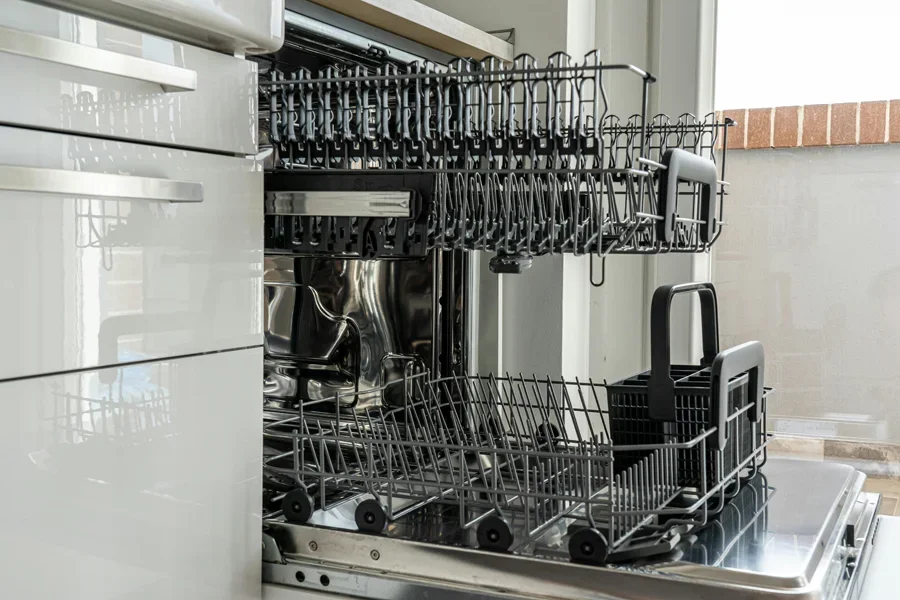Table of Contents
● Introduction
● Types of smart dishwashers and their key functions
● Overview of the 2025 smart dishwasher market
● Key features to look for in a smart dishwasher
● Leading models and their performance highlights
● Conclusion
Introduction
Smart dishwashers have rapidly become essential in modern kitchens, offering a blend of technology and convenience that redefines traditional cleaning. Equipped with advanced features like Wi-Fi connectivity, customizable wash cycles, and automated maintenance alerts, these appliances optimize efficiency while delivering high-quality results. With precise water usage controls, energy-efficient designs, and seamless integration into connected home systems, smart dishwashers cater to high standards of cleanliness and eco-consciousness. This evolution transforms dishwashing from a basic chore into a streamlined, intelligent process tailored to meet the needs of various environments.
Types of smart dishwashers and their key functions
Freestanding vs. built-in smart dishwashers

Freestanding smart dishwashers are versatile units that can be placed anywhere with access to water and drainage. They are ideal for spaces where permanent installation isn’t feasible. In contrast, built-in smart dishwashers are integrated into kitchen cabinetry, providing a seamless appearance and often offering advanced features tailored to specific kitchen designs.
Compact and full-size options
Compact smart dishwashers, typically 18 inches wide, are designed for smaller spaces, accommodating up to 10 place settings. They are suitable for environments with limited room. Full-size models, around 24 inches wide, handle larger loads, making them ideal for settings requiring higher capacity.
High-efficiency models
High-efficiency smart dishwashers focus on reducing water and energy consumption without compromising performance. They incorporate features like sensor-based wash cycles and eco-friendly modes, aligning with sustainability goals and offering long-term cost savings.
Understanding these types and their functions aids in selecting a smart dishwasher that aligns with specific requirements and operational demands.
Overview of the 2025 smart dishwasher market
Market growth and demand trends

The smart dishwasher market is experiencing significant growth, driven by increasing consumer demand for connected home appliances. According to Grand View Research, the global smart dishwasher market size was valued at USD 2.4 billion in 2019 and is anticipated to grow at a compound annual growth rate (CAGR) of 9.4% from 2020 to 2027.
This upward trajectory is attributed to rising disposable incomes, technological advancements, and a growing emphasis on energy efficiency.
Emerging features and technology in 2025
By 2025, smart dishwashers are expected to incorporate several advanced features that enhance user experience and operational efficiency. Anticipated advancements include integration with voice-activated assistants, machine learning algorithms for optimized wash cycles, and improved water and energy consumption monitoring. Additionally, developments in sensor technology are likely to enable more precise detection of load size and soil levels, resulting in more efficient cleaning processes. These innovations are set to redefine user expectations and drive further adoption of smart dishwashers in both residential and commercial settings.
Key features to look for in a smart dishwasher

Advanced cleaning and drying functions
Modern smart dishwashers incorporate precision spray technology, utilizing intelligent sensors and powerful spray arms to ensure thorough cleaning of all items. This system continuously monitors the wash cycle’s progress, adjusting as needed for optimal results. Additionally, turbo drying features enhance drying efficiency, reducing moisture and minimizing spots on dishes. These advancements contribute to superior cleaning and drying performance, meeting high standards of cleanliness.
Noise levels and energy efficiency
Quiet operation is a significant consideration in smart dishwashers, with many models operating at noise levels below 50 decibels, ensuring minimal disruption in various environments. Energy efficiency is equally important, with Energy Star-certified models offering reduced energy consumption and lower operating costs. These certifications indicate adherence to stringent energy-saving standards, promoting sustainability and cost-effectiveness.
Connectivity and smart integration
Wi-Fi connectivity enables remote monitoring and control of dishwasher functions via smartphone applications, providing convenience and flexibility. Integration with smart home systems allows for voice-activated commands and synchronization with other connected devices, enhancing user experience and operational efficiency. These features facilitate seamless integration into modern, connected environments.
Safety and sanitation features
Antibacterial and hygiene features are increasingly important, with some smart dishwashers offering high-temperature wash cycles and specialized sanitization settings to eliminate bacteria and ensure hygienic cleaning. These features are particularly beneficial in settings where maintaining high standards of cleanliness is crucial. Incorporating such safety and sanitation measures addresses health concerns and enhances overall appliance performance.
Leading models and their performance highlights

High-performance models for large-scale needs
For environments requiring robust dishwashing capabilities, certain models stand out due to their capacity and efficiency. These units often feature advanced cleaning systems with multiple spray arms and high-pressure jets, ensuring thorough cleaning even with heavy loads. Additionally, they offer flexible rack configurations to accommodate various dish sizes and types, enhancing versatility. Energy efficiency is also a key consideration, with many models meeting stringent energy-saving standards, resulting in reduced operational costs over time.
Best compact and versatile options
In settings where space is at a premium, compact smart dishwashers provide an effective solution without compromising performance. These units typically measure around 18 inches in width, making them suitable for smaller kitchens or auxiliary spaces. Despite their size, they often include features such as adjustable racks and multiple wash cycles, allowing for customization based on specific cleaning needs. Their energy-efficient designs contribute to lower utility consumption, aligning with sustainability goals.
Smart dishwashers with advanced eco features
Models emphasizing eco-friendly operations incorporate technologies designed to minimize water and energy usage. Features such as sensor-based wash cycles adjust water and energy consumption based on the load’s soil level, optimizing resource use. Additionally, eco modes operate at lower temperatures and extended cycles, effectively cleaning dishes while conserving energy. These dishwashers often hold certifications from recognized environmental standards, indicating their commitment to sustainability.

Popular picks with exceptional cleaning efficiency
Certain smart dishwashers are renowned for their consistent and reliable cleaning performance. These models utilize precision spray technology, ensuring comprehensive coverage and removal of tough residues. Advanced filtration systems prevent redepositing of food particles, maintaining cleanliness throughout the cycle. User-friendly interfaces and customizable settings further enhance their appeal, allowing for tailored cleaning experiences that meet diverse needs.
Selecting the appropriate smart dishwasher involves assessing specific requirements and operational demands. By considering factors such as capacity, space constraints, eco-friendliness, and cleaning efficiency, one can identify a model that aligns with their objectives and contributes to streamlined operations.
Conclusion
Selecting an optimal smart dishwasher in 2025 involves careful consideration of performance, eco-friendliness, and connectivity. Models designed for high-demand use deliver powerful cleaning and flexible capacity options, while compact units maximize space without sacrificing effectiveness. Advanced eco-friendly features provide significant water and energy savings, appealing to sustainability goals and lowering operational costs. Connectivity options enable remote management and seamless integration with smart home systems, boosting convenience and efficiency. By balancing these factors, buyers can identify models that align with diverse operational needs and future-forward technology.




